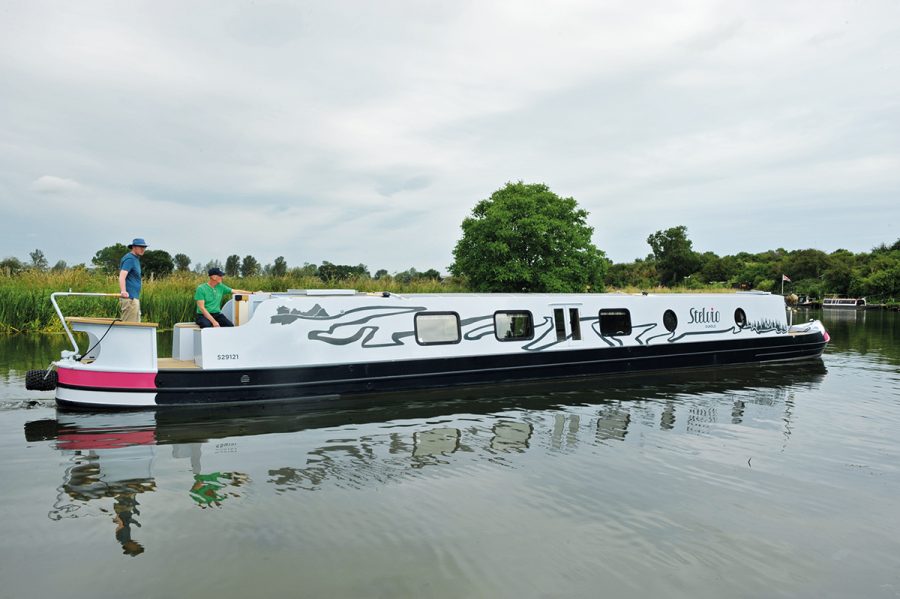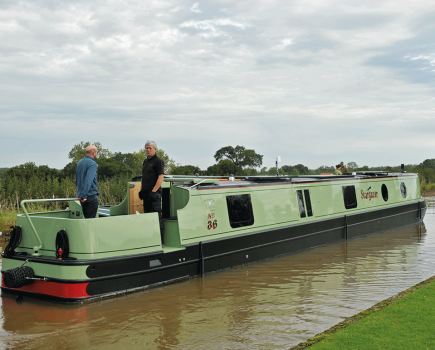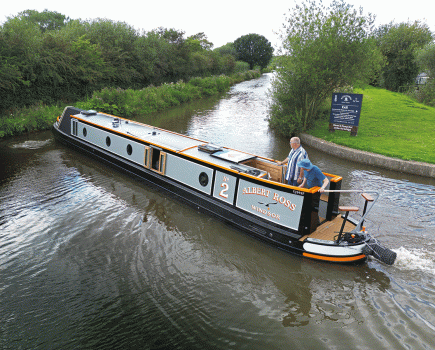As the name would suggest, this ultra-modern tug was built for two keen cyclists, as Stelvio, is an Italian mountain, which gives its name to a famous stage of the Giro d’Italia – a multi-stage bicycle race.
Words by Adam Porters | Pictures by Andy Annable
There’s something a bit special about a tug. The long flat foredeck gives a narrowboat real presence on the water, and a certain elegance that’s very appealing. But tugs normally have a rather traditional look, which isn’t surprising, given that the design is based on old working boats. But not everyone wants rivets and recessed panels.
So here’s a boat with a tug deck, Stelvio, that doesn’t look in the least bit traditional. For one thing, it’s got a long semi-cruiser stern which is all the rage right now – and its pale colour scheme with graphics down the entire length of the cabin is also very contemporary.
Another thing that’s often said about tugs is that the space under the deck is wasted. Many people would rather have more interior living space than a big front deck. But, perhaps strangely, the latest electric propulsion systems like the one this boat has, make a tug deck relevant again because it’s the ideal place for a generator —there’s plenty of room for it, it’s out of the way, and it’s a long way from where you’re standing to steer.
Stelvio is the latest boat from Mothership Marine, who started building electric propulsion boats with plenty of solar panels about five years ago. In that time, technology has moved on, and this boat has a direct drive motor, a big lithium iron phosphate battery bank, and the latest control and monitoring system.
EXTERIOR
Sometimes, the outside of a boat can tell you quite a lot about the other passions of the owners – so if you’re a cyclist or an armchair cycling fan, you can probably already tell that the couple who own this boat are with you. Stelvio is an Italian mountain, and gives its name to a famous stage of the Giro d’Italia, which starts in the forest and climbs up to a cafe on the mountain top. The superbly painted graphics on the side of the boat represent that stage. Perhaps the cleverest thing is that the route occasionally wanders onto the gunwales, and even below the gunwales, on its way along the boat. Shocking pink is the Giro’s trademark colour, so there are splashes of it here and there – on the bow flashes and tunnel band most obviously, but also in the dot of the i in the name, and on the panel which carries the Morse control on the back deck. It’s a really clever use of colour. The shell of this 65 footer is by Jonathan Wilson, and has one of his lovely curvy Josher style bows, which really suits the tug deck. At the semi-cruiser stern, the cabin sides sweep down with a curve to the height of lockers both sides. These not only provide storage, but somewhere for the crew to sit. The metal dodger round the stern has a large cutout, meaning it doesn’t look at all heavy. The deck, the locker tops, and the wide rail on top of the dodger are all covered in Flexiteek, a synthetic teak lookalike which is hard wearing and requires very little maintenance. The engine board is made from fibreglass, so it’s both strong and lightweight, and rises on gas struts. There’s plenty of room in the engine hole to store a special metal platform which hooks onto the dodger rail, and the electric barbecue which sits on top of it.

At the bow, there’s storage in the nose along with a diesel tank for the generator. The back half of the tug deck lifts, again on gas struts, to give access to the generator, but also to reveal a bike storage platform, which lifts electrically at the push of a button, so you don’t need to struggle to lift your bike out. There’s enough room for two full size racing bikes down here; who said the space under a tug deck was wasted? Also down here is a large water tank.
Above the deck there are a couple of nods towards tradition. There are traditional rings both sides of the forward bulkhead, and there’s an old brass naval light on a pole. But this is not as traditional as it seems, as the insides have been stripped out and replaced by an LED light and a camera, whose output can be seen on a screen at the helm. There’s also a tall 5G Wi-Fi antenna on top, which fortunately is hinged so it folds backwards when you go under a low bridge. It does also help to give you some idea where the bow is.
There are 12 solar panels, specially made to fill the whole width of the roof from handrail to handrail. They are bonded to the roof and there’s a cover strip to stop water getting in. The space between the two sets of panels, where there’s the ring for the centre lines and a couple of mushroom vents, is covered with a GRP panel, so it’s flush.
LAYOUT AND FITOUT
This is a reverse layout boat, with a utility area at the stern followed by the saloon which doubles as a dinette. The galley is in the centre of the boat. A walk-through shower room comes next, with the cabin at the bow.
The fitout uses reclaimed oak below the gunwales, with painted panels and trim on the cabin sides. People often think that reclaimed materials are cheap, but in fact it needs a great deal of effort to get previously-used wood looking good again. The design of the cupboard doors throughout the boat has become something of a Mothership trademark: they’re made using a simple metal frame, with planks forming the infill. All the wood gives a lovely warm tone to the boat, contrasting with the white and off-white paint. It’s all very stylish. The door furniture also matches well, with black flush ring-pull handles or black cup handles used throughout.
UTILITY
Steps lead down from the back deck into the boat. On one side is the electrical cupboard, and there’s a touchscreen display of which more later. Alongside, behind a door, is a Bosch washer dryer, with a cupboard above. On the opposite side of the boat is what you might call the downstairs loo. This tiny room has a composting toilet by Compoost.
SALOON
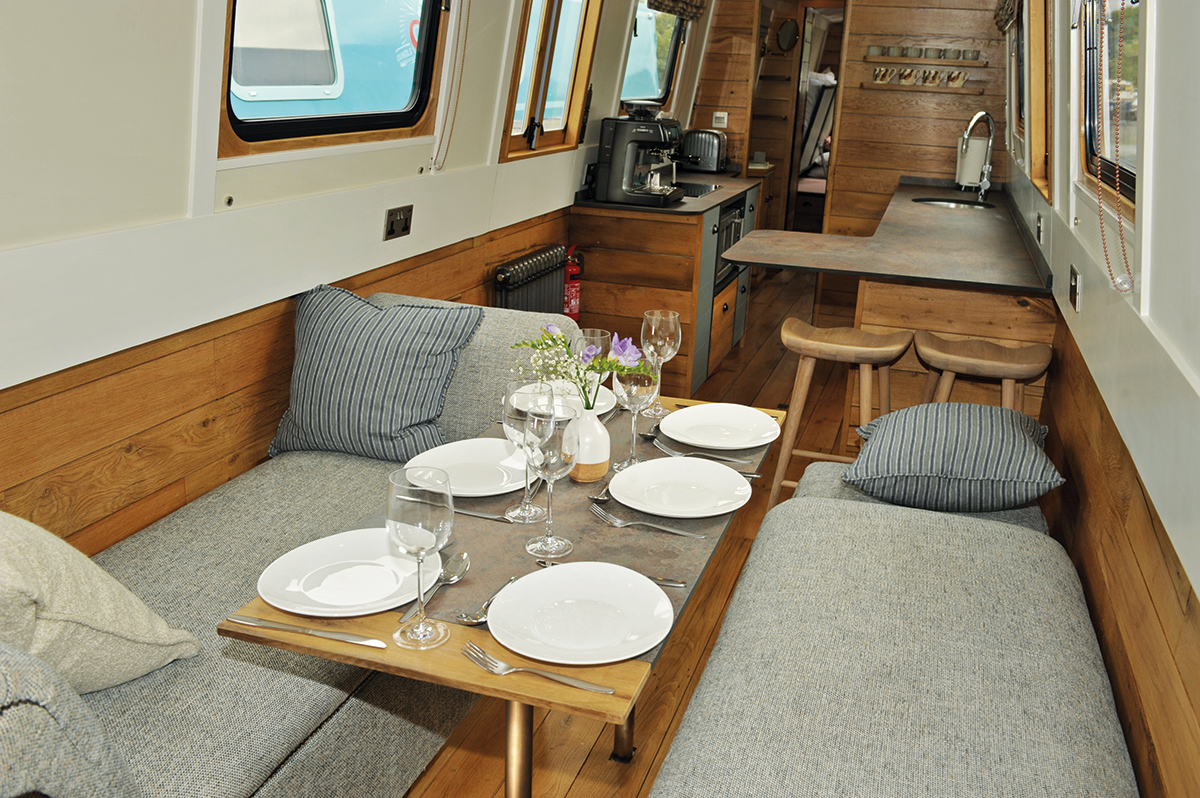
On the bulkhead in front of the washing machine are some attractive shelves, while on the opposite side of the boat is a copper Refleks diesel stove. It sits in a metal hearth with a lip, in case there’s a diesel spill, and has grey tiles behind.
The main furniture is two chaise longue style sofas, where the arms at each end can fold flat to extend the seating or to form a single guest bed. They have no backrests, but sitting in them and leaning against the cabin side is surprisingly comfortable – or you can put the arms up and sit with your feet up. They also offer storage, with one of them housing the table. There are two handles in the floor which lift out to reveal leg holes, and then the table goes on top. There are some wooden extensions for the end, meaning the full size table can seat six.
All the windows have Roman blinds, with the pull-cords held against the cabin sides to keep them in place, and magnets at the bottom of the blinds to hold them against the wall. There’s also a school-style radiator, in a raw antique finish.
GALLEY
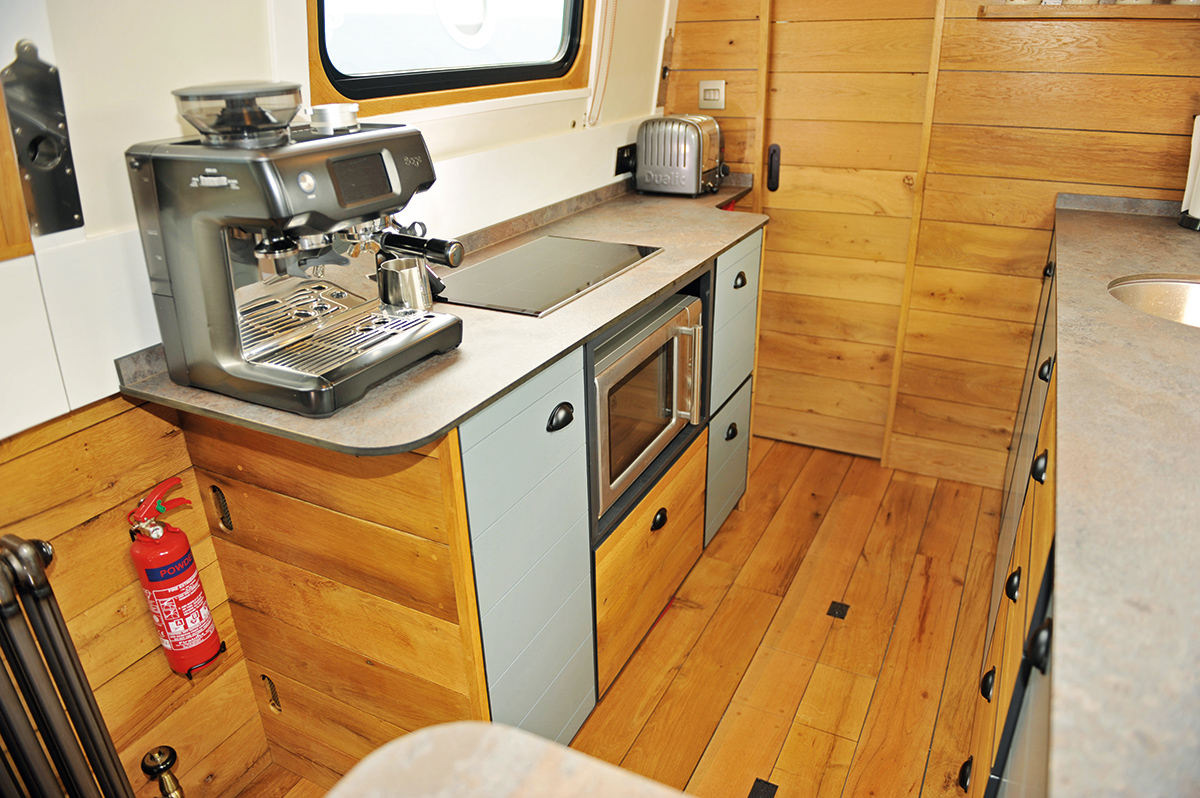
A breakfast bar with a couple of stools is the demarcation between the saloon and the galley. The worktops are made of compact laminate, which is incredibly strong and heat resistant, but also very thin. Some of the cupboard doors are reclaimed oak, while others are painted grey.
As this boat has a plentiful electrical supply, everything is electric.
There’s a Bosch two ring induction hob; there’s no full size oven, instead the owners have gone for a microwave and convection oven by Sage, which is also an air fryer. It has numerous buttons, but they’re only visible when the door is open. There’s also a Bosch slimline dishwasher behind a door, and a Quooker boiling water tap. This has a three litre vacuum tank under the sink which keeps water hot for instant boiling water. It’s actually a very efficient way of heating water, because once it’s up to temperature, it only comes on for a few seconds at a time. This tap has a second tank, so it can provide chilled and sparking water too. With the owners’ coffee machine, this is a very stylish space.
In an unusual move, there are some slots in the cabin sides so a hammock can be set up across the galley, to provide extra sleeping quarters for a child.
SHOWER ROOM
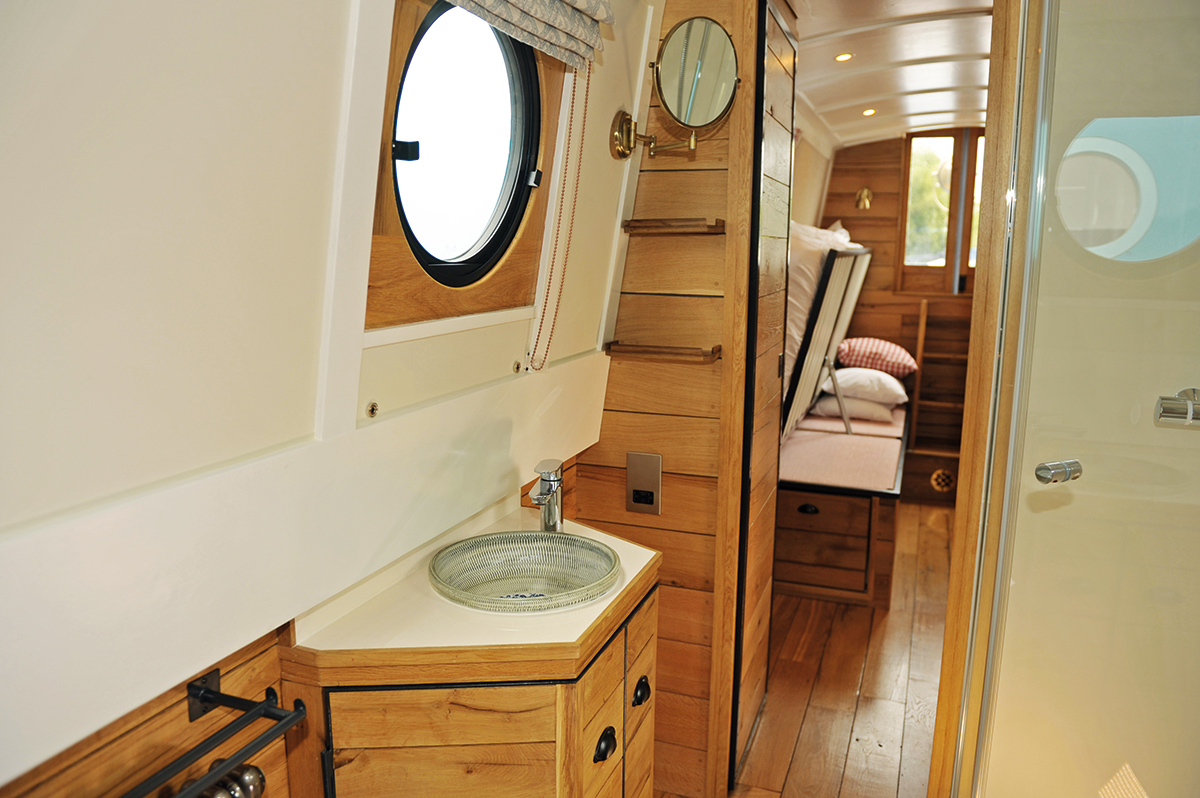
This is a room of angles. The shower cubicle is a pentangle; Mothership now make their own fibreglass shower trays and wall linings, so they can do virtually any shape. The cubicle also extends right up to the ceiling, to keep the steam in.
The basin unit is also angular, with doors that have the angle built in so that when you open them the sides are are accessible as the front. The unit is also topped with fibreglass, and has inset into it a bowl which was sourced by the owners, and which adds a splash of pattern and colour. Detailing is fine too, with a loo roll holder and towel rail made specially by a local blacksmith.
The loo is an electric incinerating one by Cinderella. Interestingly, the other loo on board was also a Cinderella, but the owners found they used so much power that it was swapped out for a composting loo. I have said this before, but I really think the makers of the incinerating loo could learn from composting toilets, and have a method of separating liquids and solids. It seems mad to me to expend lots of valuable power boiling off urine when it can so easily be dealt with at Elsans. That would leave the burning cycle for solids. In effect, this is what this boat’s owners have done – it’s just that they need two toilets to make it happen.
CABIN
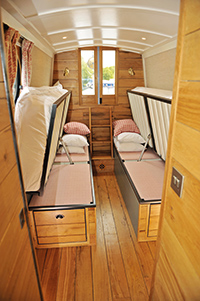
The door through from the shower room hides a vanity unit tucked into the space behind, with drawers below and an illuminated mirror above. On the opposite side of the boat is a wardrobe. The treatment on the cabin sides changes in this room. Rather than being painted, the panels are covered in a heavy duty textured wallpaper, which looks very much like a fabric and gives a touch more warmth to the room.
Gull-wing beds (or drawbridge beds, as Mothership calls them) have become another of the firm’s signatures. In the raised position, during the day, they allow free passage through the room; when they’re lowered, electrically at the press of a button, they form a bed which is king sized width, and two metres long. When they’re in the down position, the steps up to the front deck have to be moved, so they are hinged at the bottom and simply flip down. The bed bases have drawers in the ends, and there’s more storage in the form of bins when the beds are up.
The doors to the front tug deck are glazed, so there’s a blackout board to place in front of them. Because this boat is a tug, the doors are shorter than usual, so there’s a hatch above; this is made of fibreglass and is on gas struts, so it’s easy to open from inside.
TECHNICAL
Mothership’s whole founding principle was for solar powered electric boats, and this boat is the latest iteration of this. Stelvio is powered by a direct drive water cooled 15kw motor. It means it has no belts, so is particularly quiet (the firm offers a cheaper option, of a slightly smaller belt-driven motor). Mothership build both systems themselves from components, and have their own control and monitoring. The batteries are lithium iron phosphate (LiFePo4), with a capacity of 600Ah at 48 volts (which is the voltage required by the motor). To keep them charged, the solar array on the roof is over 2kw – and there’s a Fischer Panda AGT-13000 generator at the bow.
Lithium batteries are expensive, but they have the advantage of being small, charging very quickly, having a greater charge efficiency, and being able to be discharged much lower than lead acid batteries. From pretty much flat, the generator would be able to get them to a hundred per cent in around three hours. (Other boats built by Mothership have lead carbon batteries instead).
A colour touch screen display shows what’s happening with the whole system, so you can see what’s going in and out of the batteries. It can also show a whole range of historical data, so we could see for example that in June the solar panels had provided virtually all the power needed.
A really good feature is a solar dump, so if the panels are still generating and the batteries have reached 95 per cent, the power is diverted into heating water.
ON THE WATER
It almost goes without saying that an electric boat is quiet. But how quiet became clear during our test on the River Nene when we were passed by a few rowers. Not only did they comment on how they could hardly hear the boat at all, but we could actually hear what they were saying to us!
The Morse control is a slender lever, fortunately not as low down as on some cruiser sterns, thanks to the column extending through the dodger rail. It has a little button on top to engage gear, so it can’t accidentally be knocked.
There’s a slight delay between moving the control and the engine responding, so there’s a tendency at first to pile on too many revs; it doesn’t take long to get used to. The tiller is at a nice height, and the boat moves and turns extremely well, as you’d expect of a Jonathan Wilson shell. If you need the bow thruster, the controls are on the back of the column, and the thruster itself has a lot of grunt.
The touch screen display mentioned earlier is mounted on a cupboard door, and can be opened to face the helm while under way. It shows what’s going in and out of the batteries as well as the temperature of the motor, and (thanks to gps) your speed over the ground.
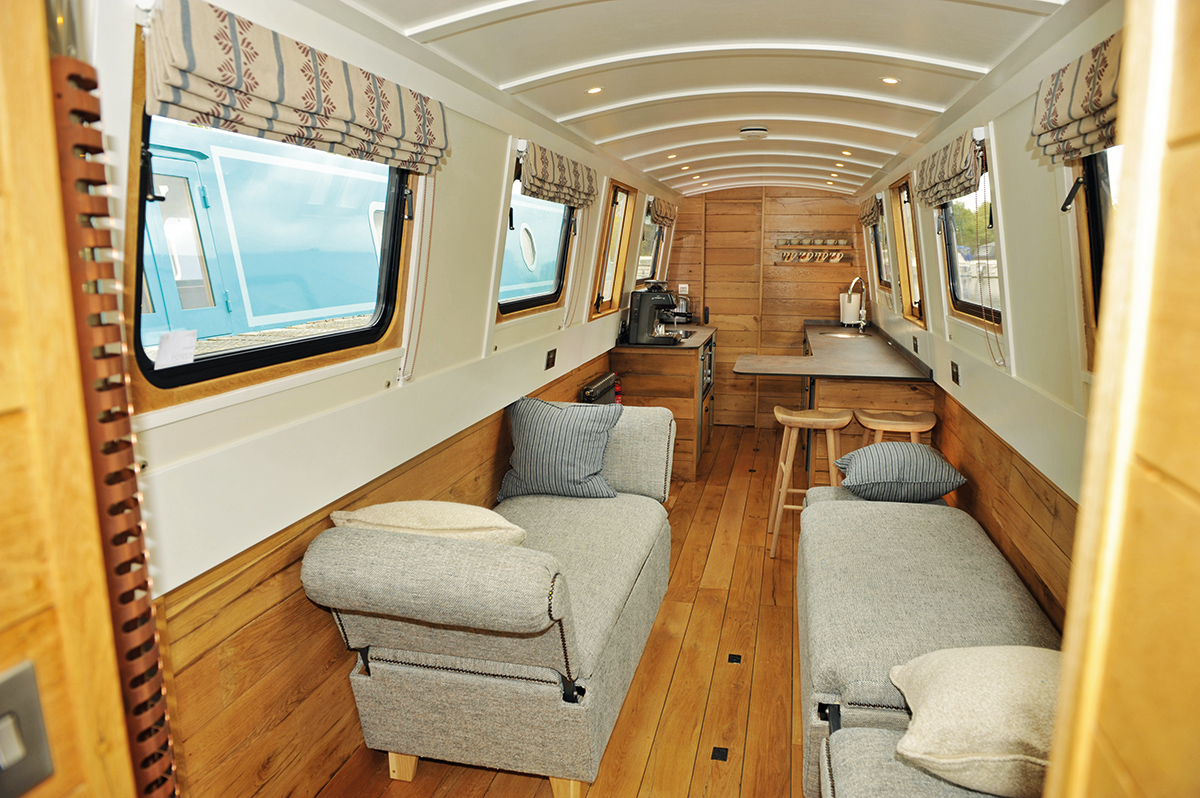
CONCLUSION
This is a very stylish boat, both inside and out. It’s also extremely well equipped, with every mod con you could want. Mothership Marine boats start at around £250,000; this one will have cost more, because of all the extra kit, such as the lithium batteries, and the incinerating loo. Anyone who’s been following boat prices recently, though, will know that such a price is not unreasonable for a boat like this.
It’s unashamedly modern – just look at the colour scheme and graphics, the semi-cruiser stern, and the technology on board. But it’s also that most traditional of narrowboat breeds, a tug. Which just goes to show that it is possible to take a traditional shape and use it in a modern way.
MOTHERSHIP MARINE
Tim Knox has had a varied career, but boats have always been part of his life. He spent five years in the Merchant Navy after leaving school at 17, but then did a degree in wood science which explains his love of reclaimed timber. He had a company making windows and other joinery for listed buildings, before taking a turn into advertising.
He lived in France, then moved to Australia for 14 years, where Mothership Marine was born. It made a solar powered house boat, with which he had help from the University of New South Wales and its Department for Photovoltaics and Renewable Energy.
Returning to the UK in 2016, Tim began work on a more British type of boat. At his workshop at Oundle on the River Nene, he has facilities for moulding GRP as well as building narrowboats, and is currently working on a solar powered fibreglass day boat.
Specification
Length: 65ft
Beam: 6ft 10in
Shell: Jonathan Wilson
Style: Semi-cruiser
Layout: Reverse
Berths: 2+1+1
Fit-out: Reclaimed oak, painted panels
Electric motor: 15kw peak / www.mothershipmarine.com
Generator: Fischer Panda AGT-13000 / www.fischerpanda.co.uk
Combi oven: Sage SMO870 – £399.95 / www.sageappliaces.com
Boiling water tap: Quooker with Cube – £2,300 / www.quooker.com
Incinerating toilet: Cinderella Comfort – £3,749 / www.cinderellauk.com
£250,000
CONTACT
Mothership Marine
Oundle Marine, Oundle
Northants, PE8 5PB
07496 574434
admin@mothershipmarine.com
www.mothershipmarine.com
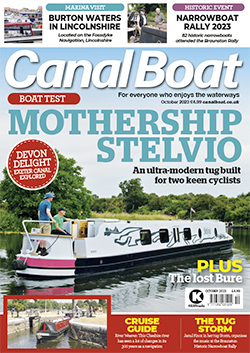 As featured in the October 2023 issue of Canal Boat. Buy the issue here
As featured in the October 2023 issue of Canal Boat. Buy the issue here

